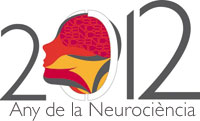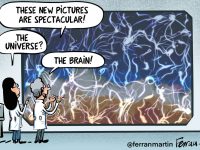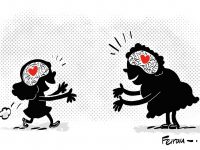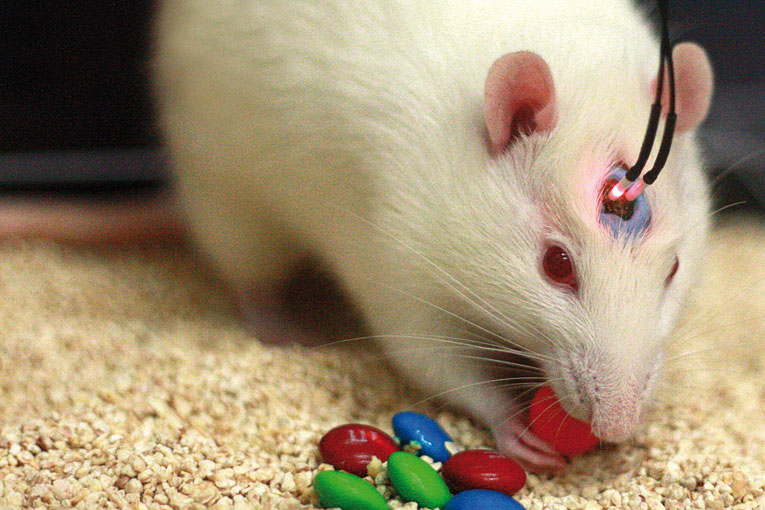
 © Mike JF Robinson / Berridge Lab Optogenetics allows behaviour modification in some animals activating or inactivating specific neurons with light. In this picture we can see a mouse with a fiberoptic implant (Michigan University). |
||
The last two decades have witnessed unprecedented advances in neuroscience and we are getting closer to understand how our brain works. This is so thanks to technical and methodological developments, but particularly thanks to new approaches to experimental designs. New knowledge about how the brain operates is helping in the development of new therapeutic tools that can cure, or at least alleviate, the symptoms of neurological diseases or psychiatric disorders. However, these developments are not free from risks and entail moral dilemmas society has to face. |
|
|
|
In October 2010, the Spanish Parliament declared 2012 the Year of Neuroscience in Spain, under the initiative of the Spanish Society for Neuroscience (SENC). The initiative was promoted as «a unique opportunity to promote neuroscientific research in universities and research centres in our country, to encourage the transfer of knowledge about the brain to society and to foster the teaching of how the brain works in schools as well as its diffusion to the general public». The proposal was passed by all votes with only one abstention. However, ever since, not only there have been no budget items to support neuroscience research in Spain, but the State’s investment on R&D has alarmingly decreased as well. Government cutbacks have strongly affected this year’s budget for research and knowledge transfer (which has decreased 25.5% in relation to the already weak budgets of 2011). Only 35% of the biomedical projects submitted to the Spanish Ministry of Economy and Competitiveness have been approved and biomedicine includes most projects on neuroscience. This means that almost 400 biomedical projects will remain unfunded. Therefore we can claim that neuroscientific research in our country has not been promoted, and, at this pace, it will rapidly decrease. Nevertheless, the goal of diffusing neuroscience all along the year has been more successful and there have been many initiatives to make society aware of the advances in nervous system research (most of them promoted by the SENC). Many scientific societies, universities and research centres have contributed to this diffusion. The articles included in this dossier represent Mètode’s small contribution to the task of communicating neuroscience. Mètode’s 23rd issue featured a monograph on the brain, which I had the pleasure to coordinate. It was the autumn of 1999 and therefore the end of the 1990’s, a decade that had been declared «The Brain Decade» by the USA Congress. The Brain Decade meant an important boost for basic and applied brain research, not only in the USA, but also in many other countries, including the EU countries, since from then on funding neuroscientific research was considered a top priority. The eight articles that made up the previously mentioned monograph were a review of the significant progress made in that area at the time. It is interesting rereading those articles and finding that they are still fully in force after thirteen years. Of course research has progressed since then, but many of the topics dealt with at the moment, which were only germinating by then, have now reached maturity — stimulation and brain activity recording techniques, neuroendocrinology, research on adult neurogenesis and regeneration, or the complex interaction between genes and environment in the development of a healthy and an unhealthy brain. This article addresses the following questions: What has happened for the last thirteen years? What are neuroscience’s hot topics nowadays? How have survey techniques improved? How have our ideas changed regarding the brain? I do not intend to make a thorough review of the topic, since it would take a whole book to do so. What I intend to do is an overview of the most recent developments in the area and the future perspectives they entail as well as the moral dilemmas they pose. |
||
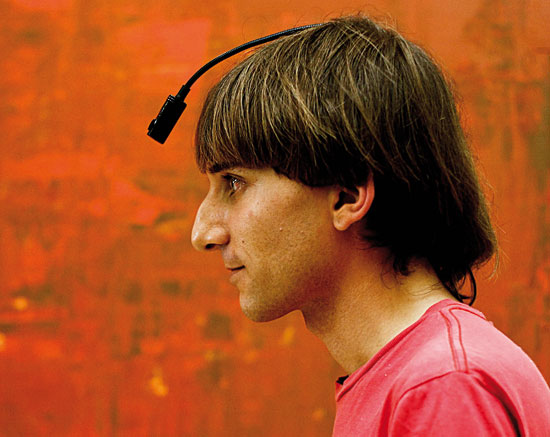 © Campus Party México Neil Harbisson suffers from achromatopsia, a visual impairment that makes him see the world in black and white. He has an «electronic eye» (eyeborg) ever since he was 20 years old. This eye enables him to «listen to colours». In 2010, Harbisson created the Cyborg Foundation, an international organisation that defends cyborgs’ rights. |
«Neuroscientific research in Spain has not been promoted, and, at this pace, it will rapidly decrease» |
|
|
decoding THE BRAIN The tools neuroscientists have nowadays enable them to set goals which were just science fiction only two decades go. Everyday we are a step closer to achieve objectives like «mind reading» or « mind manipulation». Although we are still far from deciphering the most complex thoughts and memories, the progress shown in recent years is tremendous. The increasing accuracy in neuroimaging techniques, combined with the development of increasingly sophisticated computational model techniques (computational neuroscience has spread rapidly), is making this possible. In the last five years, researchers have published studies in which they decode images (either fixed or in motion) seen by people. They do so by using appropriate software that registers brain activity at the moment the subject is watching those images. For this purpose, they had previously taught the computer to relate activation patterns in the visual cortex —registered with fMRI scans obtained from different individuals— with the images that produce this activation. Afterwards, the computer is capable of reproducing the images an individual is seeing by reading the activation patterns in his or her visual cortex as shown in the fMRI scan. Right now the image resolution1 is not a very good one, but we can recognise whether the subject is seeing a talking person, a landscape or a text. Curiously enough, some texts appear over the image reproduced while these do not appear in the videos shown to the subjects of the experiment. Nobody knows where these words come from —probably they are only noise caused by methodological limitations, but it is extremely appealing to think that the subject’s visual cortex is representing —visualising— the words that make up his or her chain of thought. In this case we would be fairly closer to, literally, «mind reading». Similar studies focus on hearing and language. In this case the computer is capable of decoding brain waves, registered by electrodes, and reproducing the words a person is listening to. Other research projects have gone a step further and have been able to detect whether a memory is real or not. Others have even been capable of knowing the decision someone is going to make (if he or she pushes a button either on the left or on the right) a few seconds before he or she is aware if having made the decision. Results of the later experiment —carried out by doctor John Dylan Haynes’ research group— suggest that the feeling of awareness of our acts may only be an illusion and our brain makes most of our decisions (if not all of them) before we are aware of them. This only confirms what most neuroscientists have been claiming for decades: «we are our brain». Humans tend to think of themselves in a dualistic way: we think a conscious self inhabits a body that possesses a brain. Neuroscience is providing data in favour of identifying the self and the brain. These data are shaking the foundations of some deep-rooted ideas about consciousness (which may not be the subject of an action but a mere observer), reasoning, decision-making and ultimately morality and free will. Precisely research on the neural mechanisms involved in decision-making has developed dramatically in recent years. It has even emerged as a new discipline within neuroscience (an economy) —neuroeconomy. Neuroeconomy studies the human brain while it makes economic decisions. For this purpose, researchers register brain activity, using neuroimaging techniques or an electroencephalogram, while experimental subjects play games where they must make decisions that entail economic loss or gain (by playing, for instance, the «Ultimatum Game»). Results of this study show the strong influence our emotions have in decision-making. When reason and emotion come into conflict with each other, healthy people are driven by emotion. The interest this kind of research arouses is easily understood if we think about its possible applications to marketing. In fact, a new applied discipline called neuromarketing has emerged. Neuormarketing studies the effects publicity has on the human brain with the intention of being able to predict and manipulate the consumer’s behaviour. |
||
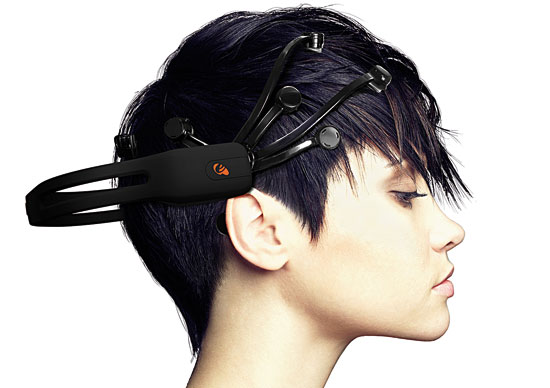 © Emotiv Companies like Emotiv are selling brain-computer interfaces that register brain signals to interact with a computer with appropriate software for less than $300. These devices can make life easier for the handicapped, but can also be used as mere entertainment. |
«Neuroscience is providing data that are shaking the foundations of some deep-rooted ideas about consciousness, reasoning, decision-making and ultimately morality and free will» |
|
| Full text available in Spanish and Catalan.
|
||
|
1 You can access the images in this video made by Doctor Gallant’s research group at Berkeley University (California) (Back to text) Bibliography Ester Desfilis. Psicobiologist, Experimental Medicine Department. University of Lleida (UdL). |
||
Bibliografia
Gilbert et al., 2005. «Genetic Links Between Brain Development and Brain Evolution». Nature Reviews Genetics, 6: 581-590.
Hill, R. S. i C. A. Walsh, 2005. «Molecular Insights into Human Brain Evolution». Nature, 437: 64-67.
Nishimoto, S. et al., 2011. «Reconstructing Visual Experiences from Brain Activity Evoked by Natural Movies». Current Biology, 21: 1641-1646.
Soon, C. S. et al., 2008. «Unconscious Determinants of Free Decisions in the Human Brain». Nature Neuroscience, 11: 543-545.
The Enconde Project Consortium, 2012. «An Integrated Encyclopedia of DNA Elements in the Human Genome». Nature, 489: 57-74.

